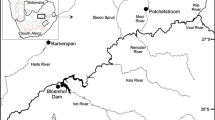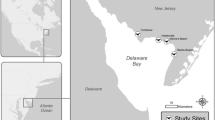Abstract
An ecological risk assessment of the spatial distribution of metal concentrations along the Hanford Reach of the free-flowing Columbia River in southcentral Washington, identified great blue herons, Ardea herodias, at potential risk through the ingestion of contaminated riverine biota, especially fish. We measured metal concentrations in livers of pre-flight herons from the Hanford Reach and excrement samples taken from the same nests. Nests were distributed among three colonies situated upstream and downstream from nine retired plutonium production reactors along the river where metals in reactor coolant waters had been released directly into the river or disposed to shoreline retention basins and ditches. Distances traveled by parent herons to foraging areas along the river shore were determined by visually tracking parent birds as they flew from nests to upriver and downriver foraging sites. Foraging flight distances varied between colonies with mean distances ranging between 0.7 and 3.1 km. Cadmium, Cr, and Pb concentrations were higher in excrement than in the livers of pre-flight herons but the opposite was noted for Cu, Hg, and Zn. Highest metal concentrations of Cr, Cu, Zn, Cd, and Pb, were measured in excrement taken from heron nests at the colony located upstream from all reactors. These results were consistent with metal concentrations reported in river sediment from the same regions, indicating excrement from the heron nests may be a useful indicator of dietary uptake of metals by herons. Fledging success and eggshell thickness measurements were used as an index of health of the local heron population. The results indicate that the reproductive health of great blue herons nesting along the Hanford Reach is among the highest reported in the continental United States.
Similar content being viewed by others
References
Becker, C.D.: 1990, Aquatic Bioenvironmental Studies: The Hanford Experience 1944–1984, Elsevier, New York, 306 pp.
Becker, J.M., Brandt, C.A. and Dauble, D.D.: 1998, ‘Species selection for an ecological risk assessment,’, Environ. Toxicol. Chem. 17, 2354–2357.
Blus, L.J., Henny, C.J. and Kaiser, T.E.: 1980, ‘Pollution ecology of great blue herons in the Columbia Basin, Oregon and Washington,’, Murrclet 61, 63–71.
Collazo, J.A.: 1981, ‘Some aspects of the breeding ecology of the great blue heron at Heyburn State Park,’, Northwest Sci. 55, 293–297.
Cushing, C.E., Watson, D.G., Scott, A.J. and Gurtisen, M.: 1981, Decrease of radionuclides in Columbia River biota following closure of Hanford reactors’, Health Phys. 41, 59–67.
Dirkes, D.C. and Hanf, R.W.: 1988, Hanford Site Environmental Report for Calendar Year 1997, Pacific Northwest National Laboratory, Richland, WA.
Eisler, R.: 2000, Chemical Risk Assessment, Health Hazards to Humans, Plants and Animals, Vol. 1, Metals, Lewis Publishers, New York, 738 pp.
Elliott, S.E., Butler, R.W., Norstrom, R.S. and Whitehead, P.E.: 1989, ‘Environmental contaminants and reproductive success of great blue herons (Ardea herodias) in British Columbia 1986–87,’, Environ. Pollut. 59, 91–114.
Fitzner, R.E. Blus L.J., Henny, C.J. and Carlile, D.W.: 1988, ‘Organochlorine residues in great blue herons from the Northwestern United States,’, Colon Waterbirds 11(2), 293–300.
Fitzner, R.E., Rickard, W.H. and Hinds, W.T.: 1982, ‘Excrement from heron colonies for environmental assessment of toxic elements,’, Environ. Monit. Assess. 1, 383–386.
Gochfeld, M.: 1975, ‘Developmental defects in common terns of Western Long Island, New York,’, Auk 92, 58–65.
Goede, A.A.: 1985, ‘Mercury, selenium, arsenic, and zinc in Waders from the Dutch Wadden Sea,’, Environ. Pollut. 37, 287–309.
Halbrook, R.S., Brewer Jr., R.L. and Buehler, D.A.: 1999, ‘Ecological risk assessment in a large river–reservoir. 7. Environmental contaminant accumulation and effects in great blue heron,’, Environ. Toxicol. Chem. 18(4), 641–648.
Henny, C.J. and Bethers, M.R.: 1971, ‘Population ecology of the great blue heron with special reference to Western Oregon,’, Can. Field-Nat. 85, 205–209.
Henny, C.J., Hill, E.F., Hoffman, D.J., Spalding, M.G. and Grove, R.A.: 2002, ‘Nineteen century mercury: Hazard to wading birds and cormorants of the Carson River, Nevada,’, Ecotoxicology 11, 213–231.
Johnson, V.A.: 1999, ‘Contaminant loading limits for a major north temperate river system: A benthic eco risk assessment approach,’, Adv. Environ. Eng. 3, 28–48.
Marco, J.D.: 1997, ‘Factors Affecting Great Blue Heron Reproduction in Southcentral Washington,’, Master of Science Thesis, University of Idaho, Moscow, ID, USA.
Mielke, P.W.: 1991, ‘The application of multivariate permutation methods based on distance functions in the earth sciences,’, Earth Sci. Rev. 31(1), 55–71.
Patton, G.W. and Crecelius, E.A.: 2001, Simultaneously Extracted Metals/Acid-Soluble Sulfide and Total Metals in Surface Sediment from the Hanford Reach of the Columbia River and the Lower Snake River, PNNL-13417, Pacific Northwest National Laboratory, Richland, WA, USA.
Patton, G.W., Tiller, B.L., Antonio, E.J., Poston, T.M. and Van Verst, S.P.: 2003, Survey of Radiological and Chemical Contaminants in the Near-Shore Environment at the Hanford Site 300 Area, PNNL-13692, Rev. 1, Pacific Northwest National Laboratory, Richland, WA, USA.
Peterson, R.T.: 1969, ‘The Contamination of Food Chains,’, in: Hickey, S.S. (ed), Peregrine Falcon Populations, Their Biology and Decline, University of Wisconsin Press, Madison, WI, USA, pp. 529–534.
Pratt, H.M.: 1970, ‘Breeding ecology of great blue herons and common egrets in Central California,’, Condor 72, 407–416.
Pratt, H.M. and Winkler, D.W.: 1985, ‘Clutch size, timing of laying and reproduction success in a colony of great blue herons and great egrets,’, Auk 102, 49–63.
Rickard, W.H. and Tiller, B.L.: 2003, ‘Observations on the nesting distribution of great blue herons on the Hanford Reach of the Columbia River,’, Northwest Sci. 77, 352–360.
Thompson, D.R., Furness, R.W. and Barrett, R.T.: 1992, ‘Mercury concentrations in seabirds from colonies in the Northeast Atlantic,’, Arch. Environ. Contam. Toxicol. 23, 383–389.
U.S. Department of Energy, Richland Operations Office (DOE-RL): 1998, Screening Assessment and Requirements for a Comprehensive Assessment, DOE/RL-96-16, Rev. 1, Technical Report, DOE-RL, Richland, WA, USA.
Vermeer, K.: 1969, ‘Great blue heron colonies in Alberta,’, Can. Field-Nat. 83, 237–242.
Author information
Authors and Affiliations
Corresponding author
Rights and permissions
About this article
Cite this article
Tiller, B.L., Marco, J.D. & Rickard, W.H. Metal Concentrations, Foraging Distances, and Fledging Success of Great Blue Herons Nesting along the Hanford Reach of the Columbia River. Environ Monit Assess 104, 71–79 (2005). https://doi.org/10.1007/s10661-005-1603-y
Received:
Accepted:
Issue Date:
DOI: https://doi.org/10.1007/s10661-005-1603-y




